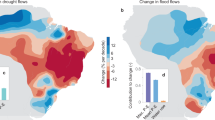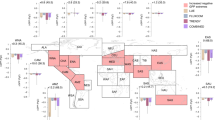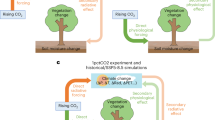Abstract
Several different drivers are contributing to climate change within the Amazon basin, including forcing from greenhouse gases and aerosols, plant physiology responses to rising CO2, and deforestation. Attribution among these drivers has not been quantified for Shared Socioeconomic Pathway (SSP) climate simulations. Here we identify the contribution of CO2 physiology and deforestation to future hydroclimate change in the Amazon basin by combining information from four experiments and eight different Earth system models in Coupled Model Intercomparison Project Phase 6. Together, forcing from CO2 physiology and deforestation account for about 44% of the projected annual precipitation decline, 48% of surface relative humidity decline and 11% of warming over the Amazon basin by 2100 for SSP3-7.0. Other Coupled Model Intercomparison Project Phase 6 SSP simulations have similar contributions from the two drivers. Insight from our attribution analysis can aid in identifying research priorities aimed at reducing uncertainty in future projections of water availability, carbon dynamics and wildfire risk.
This is a preview of subscription content, access via your institution
Access options
Subscribe to this journal
Receive 12 digital issues and online access to articles
$99.00 per year
only $8.25 per issue
Buy this article
- Purchase on Springer Link
- Instant access to full article PDF
Prices may be subject to local taxes which are calculated during checkout





Similar content being viewed by others
Data availability
All CMIP6 simulations used in this study are publicly available at https://esgf-node.llnl.gov/projects/cmip6/. Atmospheric CO2 concentrations for future SSP scenarios were downloaded from https://esgf-node.llnl.gov/projects/input4mips/. Future land use datasets LUHv2f were downloaded from https://luh.umd.edu/data.shtml. Data supporting each major figure can be accessed from ref. 73. Raw data underlying figures from Figs. 1–4 are available at https://doi.org/10.6084/m9.figshare.23826222.
Code availability
All computer codes used in this study are available via GitHub at https://github.com/YueLi92/Contributions_CO2Phys_Def_SSP.
References
Malhi, Y. et al. Exploring the likelihood and mechanism of a climate-change-induced dieback of the Amazon rainforest. Proc. Natl Acad. Sci. USA 106, 20610–20615 (2009).
Phillips, O. L. et al. Drought sensitivity of the Amazon rainforest. Science 323, 1344–1347 (2009).
Brando, P. M. et al. Abrupt increases in Amazonian tree mortality due to drought–fire interactions. Proc. Natl Acad. Sci. USA 111, 6347–6352 (2014).
Aragão, L. E. et al. 21st century drought-related fires counteract the decline of Amazon deforestation carbon emissions. Nat. Commun. 9, 1–12 (2018).
Orlowsky, B. & Seneviratne, S. I. Elusive drought: uncertainty in observed trends and short-and long-term CMIP5 projections. Hydrol. Earth Syst. Sci. 17, 1765–1781 (2013).
Mankin, J. S., Seager, R., Smerdon, J. E., Cook, B. I. & Williams, A. P. Mid-latitude freshwater availability reduced by projected vegetation responses to climate change. Nat. Geosci. 12, 983–988 (2019).
Cook, B. I. et al. Twenty‐first century drought projections in the CMIP6 forcing scenarios. Earth Future 8, e2019EF001461 (2020).
Parsons, L. A. Implications of CMIP6 projected drying trends for 21st century Amazonian drought risk. Earth Future 8, e2020EF001608 (2020).
Ukkola, A. M., De Kauwe, M. G., Roderick, M. L., Abramowitz, G. & Pitman, A. J. Robust future changes in meteorological drought in CMIP6 projections despite uncertainty in precipitation. Geophys. Res. Lett. 47, e2020GL087820 (2020).
Fan, X., Miao, C., Duan, Q., Shen, C. & Wu, Y. Future climate change hotspots under different 21st century warming scenarios. Earth Future 9, e2021EF002027 (2021).
Li, H. et al. Drylands face potential threat of robust drought in the CMIP6 SSPs scenarios. Environ. Res. Lett. 16, 114004 (2021).
Zhao, T. & Dai, A. CMIP6 model-projected hydroclimatic and drought changes and their causes in the twenty-first century. J. Clim. 35, 897–921 (2022).
O’Neill, B. C. et al. The scenario model intercomparison project (ScenarioMIP) for CMIP6. Geosci. Model Dev. 9, 3461–3482 (2016).
Riahi, K. et al. The shared socioeconomic pathways and their energy, land use, and greenhouse gas emissions implications: an overview. Glob. Environ. Change 42, 153–168 (2017).
Boit, A. et al. Large-scale impact of climate change vs. land-use change on future biome shifts in Latin America. Glob. Chang. Biol. 22, 3689–3701 (2016).
Koch, A. & Kaplan, J. O. Tropical forest restoration under future climate change. Nat. Clim. Change 12, 279–283 (2022).
Munia, H. A. et al. Future transboundary water stress and its drivers under climate change: a global study. Earth Future 8, e2019EF001321 (2020).
Park, C. Y. et al. How Will deforestation and vegetation degradation affect global fire activity? Earth Future 9, e2020EF001786 (2021).
Silva, M. V. M. D. et al. Naturalized streamflows and Affluent Natural Energy projections for the Brazilian hydropower sector for the SSP2-4.5 and SSP5-8.5 scenarios of the CMIP6. J. Water Clim. Chang. 13, 315–336 (2021).
Hall, A. & Qu, X. Using the current seasonal cycle to constrain snow albedo feedback in future climate change. Geophys. Res. Lett. 33, L03502 (2006).
Chen, Y., Langenbrunner, B. & Randerson, J. T. Future drying in central america and northern south america linked with atlantic meridional overturning circulation. Geophys. Res. Lett. 45, 9226–9235 (2018).
Duffy, P. B., Brando, P., Asner, G. P. & Field, C. B. Projections of future meteorological drought and wet periods in the Amazon. Proc. Natl Acad. Sci. USA 112, 3172–13177 (2015).
Boisier, J. P., Ciais, P., Ducharne, A. & Guimberteau, M. Projected strengthening of Amazonian dry season by constrained climate model simulations. Nat. Clim. Change 5, 656–660 (2015).
Swann, A. L., Hoffman, F. M., Koven, C. D. & Randerson, J. T. Plant responses to increasing CO2 reduce estimates of climate impacts on drought severity. Proc. Natl Acad. Sci. USA 113, 10019–10024 (2016).
Kooperman, G. J. et al. Forest response to rising CO2 drives zonally asymmetric rainfall change over tropical land. Nat. Clim. Change 8, 434–440 (2018).
Richardson, T. B. et al. Carbon dioxide physiological forcing dominates projected eastern Amazonian drying. Geophys. Res. Lett. 45, 2815–2825 (2018).
Zhou, S., Yu, B., Lintner, B., Findell, K. L. & Zhang, Y. Projected increase in global runoff dominated by land surface changes. Nat. Clim. Change 13, 442–449 (2023).
Boysen, L. R. et al. Global climate response to idealized deforestation in CMIP6 models. Biogeosciences 17, 5615–5638 (2020).
Luo, X. et al. The biophysical impacts of deforestation on precipitation: results from the CMIP6 model intercomparison. J. Clim. 35, 3293–3311 (2022).
Lehner, F. et al. Partitioning climate projection uncertainty with multiple large ensembles and CMIP5/6. Earth Syst. Dynam. 11, 491–508 (2020).
Nobre, C. A. et al. Land-use and climate change risks in the Amazon and the need of a novel sustainable development paradigm. Proc. Natl Acad. Sci. USA 113, 10759–10768 (2016).
Marengo, J. A. et al. Changes in climate and land use over the Amazon region: current and future variability and trends. Front. Earth Sci. 6, 228 (2018).
Held, I. M. & Soden, B. J. Robust responses of the hydrological cycle to global warming. J. Clim. 19, 5686–5699 (2006).
He, J. & Soden, B. J. A re-examination of the projected subtropical precipitation decline. Nat. Clim. Change 7, 53–57 (2017).
Langenbrunner, B., Pritchard, M. S., Kooperman, G. J. & Randerson, J. T. Why does Amazon precipitation decrease when tropical forests respond to increasing CO2? Earth Future 7, 450–468 (2019).
Khanna, J., Medvigy, D., Fisch, G. & de Araujo Tiburtino Neves, T. T. Regional hydroclimatic variability due to contemporary deforestation in southern Amazonia and associated boundary layer characteristics. J. Geophys. Res. Atmos. 123, 3993–4014 (2018).
Maeda, E. E. et al. Large-scale commodity agriculture exacerbates the climatic impacts of Amazonian deforestation. Proc. Natl Acad. Sci. USA 118, e2023787118 (2021).
Leite-Filho, A. T., Soares-Filho, B. S., Davis, J. L., Abrahão, G. M. & Börner, J. Deforestation reduces rainfall and agricultural revenues in the Brazilian Amazon. Nat. Commun. 12, 1–7 (2021).
Spracklen, D. V. & Garcia‐Carreras, L. J. G. R. L. The impact of Amazonian deforestation on Amazon basin rainfall. Geophys. Res. Lett. 42, 9546–9552 (2015).
Sampaio, G. et al. CO2 physiological effect can cause rainfall decrease as strong as large-scale deforestation in the Amazon. Biogeosciences 18, 2511–2525 (2021).
Lawrence, D. & Vandecar, K. Effects of tropical deforestation on climate and agriculture. Nat. Clim. Change 5, 27–36 (2015).
Jones, C. D. et al. C4MIP—the coupled climate–carbon cycle model intercomparison project: experimental protocol for CMIP6. Geosci. Model Dev. 9, 2853–2880 (2016).
Lawrence, D. M. et al. The Land Use Model Intercomparison Project (LUMIP) contribution to CMIP6: rationale and experimental design. Geosci. Model Dev. 9, 2973–2998 (2016).
IPCC Summary for Policymakers. In Climate Change 2021: The Physical Science Basis. Contribution of Working Group I to the Sixth Assessment Report of the Intergovernmental Panel on Climate Change 3–32 (eds Masson-Delmotte, V. et al.) (Cambridge Univ. Press, 2021).
Balch, J. K. et al. Warming weakens the night-time barrier to global fire. Nature 602, 442–448 (2022).
Jain, P., Castellanos-Acuna, D., Coogan, S. C. P., Abatzoglou, J. T. & Flannigan, M. D. Observed increases in extreme fire weather driven by atmospheric humidity and temperature. Nat. Clim. Change 12, 63–70 (2022).
Cheng, L. et al. Past and future ocean warming. Nat. Rev. Earth Environ. 3, 776–794 (2022).
Stickler, C. M. et al. The potential ecological costs and cobenefits of REDD: a critical review and case study from the Amazon region. Glob. Change Biol. 15, 2803–2824 (2009).
Zemp, D. C. et al. Self-amplified Amazon forest loss due to vegetation-atmosphere feedbacks. Nat. Commun. 8, 1–10 (2017).
Norby, R. J. et al. Model–data synthesis for the next generation of forest free-air CO2 enrichment (FACE) experiments. New Phytol. 209, 17–28 (2016).
Medlyn, B. E. et al. Stomatal conductance of forest species after long-term exposure to elevated CO2 concentration: a synthesis. New Phytol. 149, 247–264 (2008).
Baker, J. C. A. & Spracklen, D. V. Divergent representation of precipitation recycling in the Amazon and the Congo in CMIP6 models. Geophys. Res. Lett. 49, E2021GL095136 (2022).
Wills, R. C. J., Dong, Y., Proistosecu, C., Armour, K. C. & Battisti, D. S. Systematic climate model biases in the large-scale patterns of recent sea-surface temperature and sea-level pressure change. Geophys. Res. Lett. 49, e2022GL100011 (2022).
Barichivich, J. et al. Recent intensification of Amazon flooding extremes driven by strengthened Walker circulation. Sci. Adv. 4, eaat8785 (2018).
Weijer, W., Cheng, W., Garuba, O. A., Hu, A. & Nadiga, B. T. CMIP6 models predict significant 21st century decline of the Atlantic Meridional Overturning Circulation. Geophys. Res. Lett. 47, e2019GL086075 (2020).
Ciemer, C., Winkelmann, R., Kurths, J. & Boers, N. Impact of an AMOC weakening on the stability of the southern Amazon rainforest. Eur. Phys. J. Spec. Top. 230, 3065–3073 (2021).
Cai, X. et al. Improving representation of deforestation effects on evapotranspiration in the E3SM land model. J. Adv. Model. Earth Syst. 11, 2412–2427 (2019).
Chen, L. & Dirmeyer, P. A. Reconciling the disagreement between observed and simulated temperature responses to deforestation. Nat. Commun. 11, 1–10 (2020).
Windisch, M. G., Davin, E. L. & Seneviratne, S. I. Prioritizing forestation based on biogeochemical and local biogeophysical impacts. Nat. Clim. Change 11, 867–871 (2021).
Bright, R. M. et al. Local temperature response to land cover and management change driven by non-radiative processes. Nat. Clim. Change 7, 296–302 (2017).
Duveiller, G., Hooker, J. & Cescatti, A. The mark of vegetation change on Earth’s surface energy balance. Nat. Commun. 9, 1–12 (2018).
Gillet, N. P. et al. The Detection and Attribution Model Intercomparison Project (DAMIP v1.0) contribution to CMIP6. Geosci. Model Dev. 9, 3685–3697 (2016).
Schulzweida, U. Climate data operators (CDO) user guide (Version 1.9.8). Zenodo https://doi.org/10.5281/zenodo.3539275 (2019).
Wu, T. et al. The Beijing Climate Center climate system model (BCC-CSM): the main progress from CMIP5 to CMIP6. Geosci. Model Dev. 12, 1573–1600 (2019).
Swart, N. C. et al. The Canadian Earth System Model version 5 (CanESM5. 0.3). Geosci. Model Dev. 12, 4823–4873 (2019).
Danabasoglu, G. et al. The Community Earth System Model version 2 (CESM2). J. Adv. Model Earth Syst. 12, e2019MS001916 (2020).
Séférian, R. et al. Evaluation of CNRM Earth System Model, CNRM‐ESM2‐1: role of Earth system processes in present‐day and future climate. J. Adv. Model Earth Syst. 11, 4182–4227 (2019).
Boucher, O. et al. Presentation and evaluation of the IPSL-CM6A-LR climate model. J. Adv. Model Earth Syst. 12, 1–52 (2020).
Kelley, M. et al. GISS‐E2. 1: configurations and climatology. J. Adv. Model Earth Syst. 12, e2019MS002025 (2020).
Sellar, A. A. et al. Implementation of UK Earth system models for CMIP6. J. Adv. Model Earth Syst. 12, e2019MS001946 (2020).
Mauritsen, T. et al. Developments in the MPI‐M Earth System Model version 1.2 (MPI‐ESM1. 2) and its response to increasing CO2. J. Adv. Model Earth Syst. 11, 998–1038 (2019).
Hurtt, G. C. et al. Harmonization of global land use change and management for the period 850–2100 (LUH2) for CMIP6. Geosci. Model Dev. 13, 5425–5464 (2020).
Li, Y. et al. Raw data underlying figures from Fig. 1 to Fig. 4, Figshare, https://doi.org/10.6084/m9.figshare.23826222 (2023).
Acknowledgements
Y.L. and J.T.R. acknowledge support from the US Department of Energy (DOE) Office of Science, Biological and Environmental Research (BER), Earth and Environmental Systems Modeling programme to study dust and fire (DE-SC0021302) and the RUBISCO Scientific Focus Area. J.T.R. and D.C.M. received funding support from NASA’s SERVIR and MAP research programmes. A.L.S.S. recognizes funding support from DOE BER Regional and Global Model Analysis programme (DE-SC0021209). The funders had no role in study design, data collection and analysis, the decision to publish, or manuscript preparation.
Author information
Authors and Affiliations
Contributions
Y.L. and J.T.R. designed the research; Y.L. performed data analysis and figure illustrations; Y.L. and J.T.R. drafted the manuscript, with discussions and contributions from J.C.A.B., P.M.B., F.M.H., D.M.L., D.C.M., A.L.S.S. and M.R.U.; all authors reviewed and revised the manuscript.
Corresponding author
Ethics declarations
Competing interests
The authors declare no competing interests.
Peer review
Peer review information
Nature Water thanks David Lapola, Markus Reichstein, Corey Lesk and Alexander Winkler for their contribution to the peer review of this work.
Additional information
Publisher’s note Springer Nature remains neutral with regard to jurisdictional claims in published maps and institutional affiliations.
Supplementary information
Supplementary Information
Supplementary Figs. 1–7 and Tables 1–3.
Source data
Source Data Fig. 1
Raw data for Fig. 1.
Source Data Fig. 2
Raw data for Fig. 2.
Source Data Fig. 3
Raw data for Fig. 3.
Source Data Fig. 4
Raw data for Fig. 4.
Rights and permissions
Springer Nature or its licensor (e.g. a society or other partner) holds exclusive rights to this article under a publishing agreement with the author(s) or other rightsholder(s); author self-archiving of the accepted manuscript version of this article is solely governed by the terms of such publishing agreement and applicable law.
About this article
Cite this article
Li, Y., Baker, J.C.A., Brando, P.M. et al. Future increases in Amazonia water stress from CO2 physiology and deforestation. Nat Water 1, 769–777 (2023). https://doi.org/10.1038/s44221-023-00128-y
Received:
Accepted:
Published:
Issue Date:
DOI: https://doi.org/10.1038/s44221-023-00128-y



